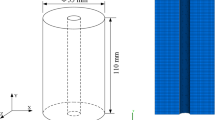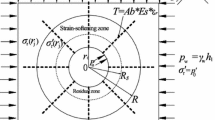Abstract
We here systematically investigated the methodology for establishing comprehensive stress paths with the aim of developing hollow cylinder apparatuses for rock mechanics. The research was based on the stress combination in element of hollow cylinder sample with varied loading analysis treatment. For this purpose, we discussed the mechanism underlying the variations in principal stress magnitude and principal stress rotation. The orientation angle of the major principal stress was defined in an alternative prospect. Then a series of stress paths was introduced, including the hydrostatic pressure stress path, principal stress magnitude variation stress path on the deviatoric plane, pure principal stress rotation stress path, and the complex stress path coupling the variation in the magnitude of principal stress and principal stress rotation effect. The comprehensive stress paths were analyzed with rock mechanical theory and a mathematical approach. The suggested loading methods were examined using simulation loading tests, laboratory case tests and special case verification. The results showed successful completion of different stress paths. The proposed methodology was first investigated systematically in rock mechanics, contributing to development of the new hollow cylinder apparatus and complex rock engineering simulation.















Similar content being viewed by others
Abbreviations
- \(F\), \({M_{\text{t}}}\), \({P_{\text{e}}}\), \({P_i}\) :
-
Vertical load, torque, external radial pressure, and internal radial pressure on HCA specimen
- \({\tilde {\sigma }_z}\), \({\tilde {\sigma }_r}\), \({\tilde {\sigma }_\theta }\), \({\tilde {\tau }_{z\theta }}\) :
-
Vertical stress, radial stress, circumferential stress, and shear stress in HCA specimen
- \({\sigma _z}\), \({\sigma _r}\), \({\sigma _\theta }\), \({\tau _{z\theta }}\) :
-
Average vertical stress, radial stress, circumferential stress, and shear stress in a continuum
- \({R_{\text{e}}}\) :
-
External specimen radii
- \({R_{\text{i}}}\) :
-
Internal specimen radii
- \(\sigma _{z}^{\prime }\) :
-
Principal stress corresponding to the vertical stress
- \(\sigma _{\theta }^{\prime }\) :
-
Principal stress corresponding to the circumferential stress
- \(\alpha\) :
-
Rotation angle of the major principal stress axis
- \({\sigma _{13}}\), \({\sigma _{31}}\), \({\tau _{13}}\),\({\tau _{31}}\) :
-
Opposite normal stresses and shear stresses in Mohr circle
- \({\sigma _1}\), \({\sigma _2}\), \({\sigma _3}\) :
-
Major, intermediate, and minor principal stresses
- \(\delta\) :
-
Rotation angle between \({\sigma _1}\) and \({\sigma _{13}}\) in Mohr circle
- \({\theta _\sigma }\) :
-
Lode angle
- \({{\mathbf{\sigma }}_{ij}}\) :
-
Cauchy stress tensor
- \({{\mathbf{S}}_{ij}}\) :
-
Stress deviator tensor
- \({S_1}\), \({S_2}\), \({S_3}\) :
-
Major, intermediate, and minor principal stress deviators
- \({J_2}\) :
-
Second deviatoric stress invariant
- \(p\) :
-
Hydrostatic pressure
- \(b\) :
-
Intermediate principal stress coefficient
- \(q\) :
-
Equivalent shear stress
- \(\dot {\alpha }\) :
-
Rotation rate of the major principal stress axis
- \(R\) :
-
The downward thrust of piston rod produced by oil pressure
References
Alsayed MI (2002) Utilising the Hoek triaxial cell for multiaxial testing of hollow rock cylinders. Int J Rock Mech Min 39(3):355–366
Amann F, Button EA, Evans KF, Gischig VS, Blumel M (2011) Experimental study of the brittle behaviour of clay shale in rapid unconfined compression. Rock Mech Rock Eng 44(4):415–430
Amann F, Kaiser PK, Button EA (2012) Experimental study of brittle behaviour of clay shale in rapid triaxial compression. Rock Mech Rock Eng 45(1):21–33
Bieniawski ZT (1967) Mechanism of brittle fracture of rock. Int J Rock Mech Min Sci 4(4):395–430
Cantieni L, Anagnostou G (2009) The effect of the stress path on squeezing behavior in tunneling. Rock Mech Rock Eng 42(2):289–318
Chen WF, Saleeb AF (2013) Constitutive equations for engineering materials: elasticity and modeling. Elsevier, Oxford
Diederichs MS, Kaiser PK, Eberhardt E (2004) Damage initiation and propagation in hard rock during tunnelling and the influence of near-face stress rotation. Int J Rock Mech Min 41(5):785–812
Ding Q, Ju F, Mao X, Ma D, Yu B, Song S (2016) Experimental investigation of the mechanical behavior in unloading conditions of sandstone after high-temperature treatment. Rock Mech Rock Eng 49(7):2641–2653
Eberhardt E (2001) Numerical modelling of three-dimension stress rotation ahead of an advancing tunnel face. Int J Rock Mech Min 38(4):499–518
Eberhardt E, Stead D, Stimpson B (1999) Quantifying progressive pre-peak brittle fracture damage in rock during uniaxial compression. Int J Rock Mech Min Sci 36(3):361–380
Feng XT, Zhang X, Kong R, Wang G (2016) A novel Mogi type true triaxial testing apparatus and its use to obtain complete stress-strain curves of hard rocks. Rock Mech Rock Eng 49(5):1649–1662
Fenner R (1938) Untersuchungen zur erkenntnis des gebirgsdrucks. Glückauf 32(74):681–695 (705–715)
Ganne P, Vervoort A (2006) Characterisation of tensile damage in rock samples induced by different stress paths. Pure Appl Geophys 163(10):2153–2170
Gutierrez M, Wang J, Yoshimine M (2009) Modeling of the simple shear deformation of sand: effects of principal stress rotation. Acta Geotech 4(3):193–201
He MC, Miao JL, Feng JL (2010) Rock burst process of limestone and its acoustic emission characteristics under true-triaxial unloading conditions. Int J Rock Mech Min 47(2):286–298
Hight DW, Gens A, Symes MJ (1983) The development of a new hollow cylinder apparatus for investigating the effects of principal stress rotation in soils. Geotechnique 33(4):355–383
Ishihara K, Towhata I (1983) Sand response to cyclic rotation of principal stress directions as induced by wave loads. Soils Found 23(4):11–26
Jiang MJ, Li QL, Yang QJ (2013) Experimental investigation on deformation behavior of TJ-1 lunar soil simulant subjected to principal stress rotation. Adv Space Res 52(1):136–146
Kong YX, Yao YP, Zhao JD (2015) Modeling principal stress rotation for anisotropic sand. Jpn Geotechn Soc Spec Publ 1(2):22–27
Lee DH, Juang CH, Chen JW, Lin HM, Shieh WH (1999) Stress paths and mechanical behavior of a sandstone in hollow cylinder tests. Int J Rock Mech Min 36(7):857–870
Lee DH, Juang CH, Lin HM (2002) Yield surface of Mu-San sandstone by hollow cylinder tests. Rock Mech Rock Eng 35(3):205–216
Lin QH, Yan JJ, Zhou J, Cao ZG (2016) Microstructure study on intact clay behavior subjected to cyclic principal stress rotation. Procedia Eng 143:991–998
Ma XD, Rudnicki JW, Haimson BC (2017) Failure characteristics of two porous sandstones subjected to true triaxial stresses: applied through a novel stress path. J Geophys Res Solid Earth 122(4):2525–2540
Miura K, Miura S, Toki S (1986) Deformation behavior of anisotropic dense sand under principal stress axes rotation. Soils Found 26(1):36–52
Nishimura S, Towhata I (2004) A three-dimensional stress-strain model of sand undergoing cyclic rotation of principal stress axes. Soils Found 44(2):103–116
O’Kelly BC, Naughton PJ (2005) Development of a new hollow cylinder apparatus for stress path measurements over a wide strain range. Geotech Test J 28(4):345–354
O’Kelly BC, Naughton PJ (2009) Study of the yielding of sand under generalized stress conditions using a versatile hollow cylinder torsional apparatus. Mech Mater 41(3):187–198
Predan J, Močilnik V, Gubeljak N (2013) Stress intensity factors for circumferential semi-elliptical surface cracks in a hollow cylinder subjected to pure torsion. Eng Fract Mech 105:152–168
Saada AS, Fries G, Ker C (1983) An evaluation of laboratory testing techniques in soil mechanics. Soils Found 23(2):98–112
Sayao A, Vaid YP (1991) A critical assessment of stress non-uniformities in hollow cylinder test specimens. Soils Found 3(1):60–72 l(
Sivathayalan S, Vaid YP (2002) Influence of generalized initial state and principal stress rotation on the undrained response of sands. Can Geotech J 39(1):63–76
Talesnick ML, Katz A, Ringel M (2000) An investigation of the elastic stress-strain behavior of a banded sandstone and a sandstone-like material. Geotech Test J 23(3):257–273
Vaid YP, Sayao A, Hou EH, Negussey D (1990) Generalized stress-path-dependent soil behavior with a new hollow cylinder torsional apparatus. Can Geotech J 27(5):601–616
Wang Z, Yang Y, Yu H, Muraleetharan KK (2016) Numerical simulation of earthquake-induced liquefactions considering the principal stress rotation. Soil Dyn Earthq Eng 90:432–441
Yang SQ (2016) Experimental study on deformation, peak strength and crack damage behavior of hollow sandstone under conventional triaxial compression. Eng Geol 213(4):11–24
Yang SQ (2018) Fracturing mechanism of compressed hollow-cylinder sandstone evaluated by X-ray micro-CT scanning. Rock Mech Rock Eng 51(7):2033–2053
Yang Y, Yu H (2013) A kinematic hardening soil model considering the principal stress rotation. Int J Numer Anal Met 37(13):2106–2134
Zhang C, Zhou H, Feng XT, Xing L, Qiu SL (2011) Layered fractures induced by principal stress axes rotation in hard rock during tunnelling. Mater Res Innov 15:S527–S530
Zhou XP (2010) Dynamic damage constitutive relation of mesoscopic heterogenous brittle rock under rotation of principal stress axes. Theor Appl Fract Mec 54(2):110–116
Zhou H, Jiang Y, Lu JJ, Gao Y, Chen J (2018) Development of a hollow cylinder torsional apparatus for rock. Rock Mech Rock Eng. https://doi.org/10.1007/s00603-018-1563-5
Acknowledgements
We gratefully acknowledge financial support from the National Science Foundation of China (NSFC) (51704097, 51427803 and 51404240), the Scientific Instrument Developing Project of Chinese Academy of Sciences (YZ201553 and YZ201344), China National Key Basic Research Program under Grant No. 2014CB046902, the Key Opening Laboratory Project for Deep Mining Construction at Henan province (2015 KF-06), the Key Scientific Research Project of Henan Higher Education Institutions (16A560004) and Dr. Fund Projects of Henan Polytechnic University (B2016-65). Besides, the authors are also grateful to the editor Giovanni Barla and the anonymous reviewers for their many helpful comments, which have greatly improved this paper.
Author information
Authors and Affiliations
Corresponding authors
Additional information
Publisher’s Note
Springer Nature remains neutral with regard to jurisdictional claims in published maps and institutional affiliations.
Rights and permissions
About this article
Cite this article
Li, Z., Zhou, H., Jiang, Y. et al. Methodology for Establishing Comprehensive Stress Paths in Rocks During Hollow Cylinder Testing. Rock Mech Rock Eng 52, 1055–1074 (2019). https://doi.org/10.1007/s00603-018-1628-5
Received:
Accepted:
Published:
Issue Date:
DOI: https://doi.org/10.1007/s00603-018-1628-5




